 |
 |
 |
| |
Raltegravir Top PIs and NNRTIs in Retrospective Look at Cancer Patients
|
| |
| |
53rd ICAAC, September 10-13, 2013, Denver
Mark Mascolini
Raltegravir-based regimens were 9 times more likely than protease inhibitor (PI) regimens to control HIV in a retrospective analysis of 154 cancer patients at MD Anderson Cancer Center in Texas [1]. Raltegravir and nonnucleoside reverse transcriptase inhibitors (NNRTIs) had similar efficacy, but raltegravir was safer than NNRTIs in this population. Raltegravir was the only integrase inhibitor prescribed during the study period.
MD Anderson researchers observed that, 30 years into the HIV epidemic, little is known about which antiretrovirals are most suitable for cancer patients. One reason for that dearth of data is routine exclusion of HIV-positive people from cancer chemotherapy trials. To shed some light on this issue, these investigators retrospectively assessed the efficacy and safety of antiretrovirals in MD Anderson patients who had cancer or hematopoietic stem cell transplantation from January 2001 through December 2012.
This record review considered only patients who had two or more clinic visits in a 6-month period and whose treatment was begun or monitored by MD Anderson infectious disease specialists. The researchers defined efficacy as (1) lack of virologic failure (viral load at or above 200 copies for 6 months or more while on antiretroviral therapy) or (2) lack of virologic rebound (viral load at or above 200 copies after virologic suppression).
The MD Anderson team considered safety and efficacy of four regimens including nucleoside reverse transcriptase inhibitors plus (1) PIs, (2) NNRTIs, (3) strand-transfer integrase inhibitors (which in this analysis included only raltegravir), or (4) any other combination of the above agents.
The analysis included 154 adults, 80% of them men and 51% white. While 30 people took a raltegravir regimen, 57 took a PI, 50 an NNRTI, and 17 some other combination. Most people (58%) had a hematologic malignancy, mainly non-Hodgkin lymphoma (NHL) (42%).
Median age stood at 51 years in the raltegravir group, 50 in the PI group, 48 in the NNRTI group, and 53 in the other-combination group. Hematologic malignancies were more common in the raltegravir group (83%) than in the PI group (42%), the NNRTI group (68%), or the other group (41%) (P < 0.001). Higher proportions in the raltegravir group (50%) and the NNRTI group (46%) had no antiretroviral experience at cancer diagnosis when compared with people in the PI group (33%) or the other group (0%) (P = 0.003).
MD Anderson clinicians prescribed raltegravir significantly more often than PIs (P = 0.002) or NNRTIs (P = 0.026) for patient taking topoisomerase inhibitors. In patients taking alkylating agents, clinicians favored raltegravir over PIs (P = 0.03), NNRTIs (P = 0.04), and other combinations (P = 0.02). Among people taking antimetabolites, raltegravir got prescribed significantly more often than PIs (P = 0.014). No antiretroviral combination got prescribed significantly more often than other combinations for patients taking cytotoxic drugs, taxanes, vinca alkyloids, antitumor antibodies, targeted therapy, corticosteroids, or radiotherapy.
Recorded antiretroviral side effects proved significantly less common with raltegravir regimens (3%) than with PI regimens (35%, P = 0.001) or NNRTI regimens (14%, P = 0.02). Only 1 of 30 people who took a raltegravir combination had recorded side effects (gastrointestinal discomfort and diarrhea). Antiretroviral interruptions proved less frequent in people taking a raltegravir regimen (7%) than in those taking a PI (28%) or an NNRTI (26%).
Raltegravir and NNRTI combinations had equivalent 6-month efficacy (96% and 97%) and significantly greater efficacy than PI regimens (65%) (P = 0.005 and P = 0.001). Among people starting their first antiretroviral regimen after cancer diagnosis, raltegravir regimens and NNRTI regimens both had 100% 6-month efficacy, compared with 60% efficacy among people who started a PI combination (P = 0.02 and P = 0.005).
Multiple logistic regression analysis determined that raltegravir regimens were 9 times more likely than PIs to be effective at 6 months (95% confidence interval 1.6 to 56.2), while NNRTIs were 6 times more likely than PIs to be effective at the 6-month point (95% confidence interval 1.1 to 39.6). Mortality was significantly lower in the raltegravir group (13%) than in the PI group (46%) or the NNRTI group (36%) (P = 0.03).
The MD Anderson team concluded that "administration of an [integrase inhibitor] or NNRTI regimen but not a PI regimen resulted in increased safety and efficacy without causing significant adverse events in HIV- infected patients who have cancer or have undergone hematopoietic stem cell transplantation." But raltegravir was safer than NNRTI regimens. The researchers proposed that integrase inhibitors (which in this study meant raltegravir) "appear to be the antiretrovirals of choice" when interactions are expected with anticancer therapy.
Although this appears to be the largest analysis of concomitant antiretroviral therapy and cancer chemotherapy, the findings are subject to the biases inherent in observational studies.
Reference
1. Torres HA, Rallapalli V, Saxena A, et al. Efficacy and safety of antiretrovirals in HIV-infected patients with cancer. 53rd ICAAC. September 10-13, 2013. Denver. Abstract H-1255.
-----------------------------------
Efficacy and Safety of Antiretrovirals in HIV-Infected Patients with Cancer
Reported by Jules Levin
Harrys A. Torres, Vijayashri Rallapalli, Abhinav Saxena, Bruno P. Granwehr, George M. Viola, Ella Ariza-Heredia, Rina Marfatia, Ying Jiang,
Javier A. Adachi, Roy F. Chemaly, Parag Mahale, Samuel A. Shelburne, and Victor Mulanovich
Department of Infectious Diseases, Infection Control & Employee Health, The University of Texas MD Anderson Cancer Center, Houston, TX
CONCLUSIONS
Administration of an INSTI or NNRTI regimen but not a PI regimen resulted in increased safety and efficacy without causing significant adverse events in HIV- infected patients who have cancer or have undergone HSCT.
When interactions of chemotherapeutic and antifungal agents are anticipated, INSTIs (specifically, raltegravir) appear to be the ARVs of choice.
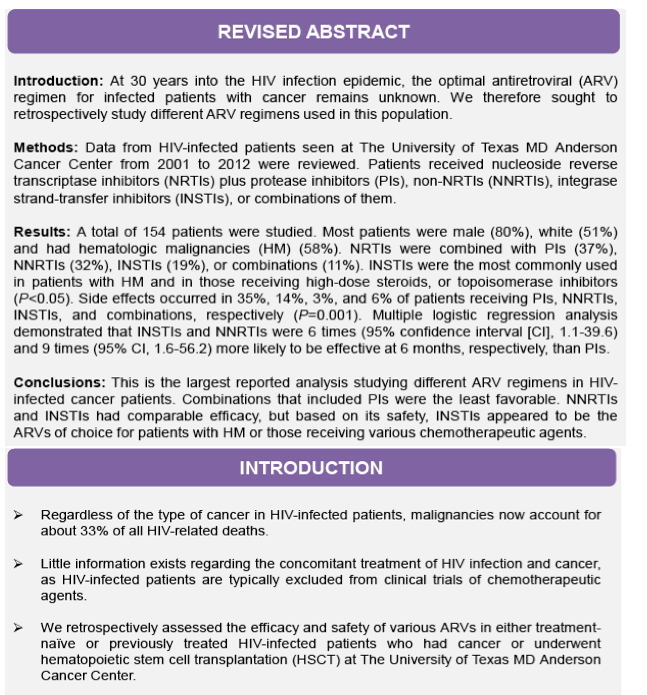
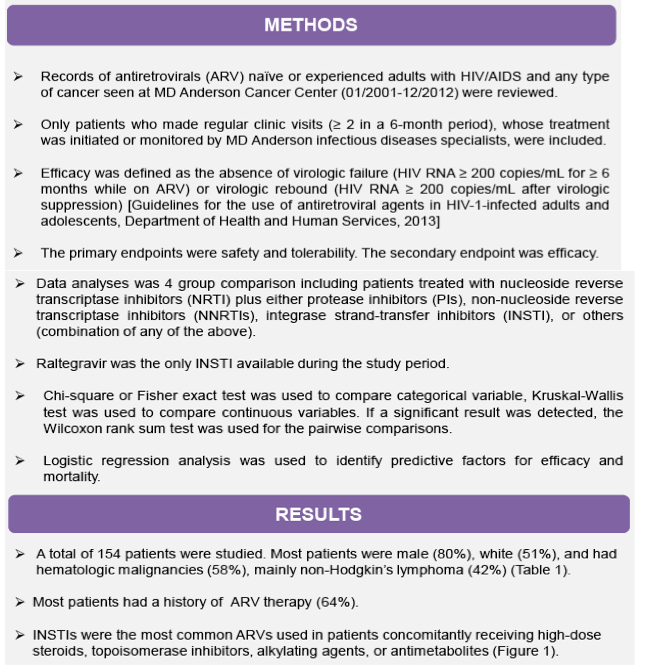
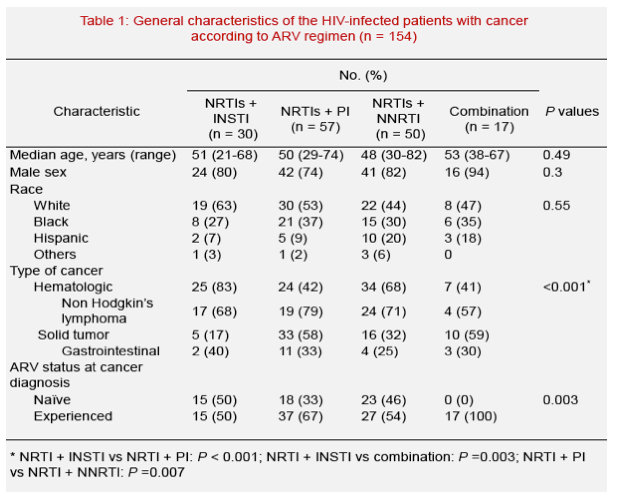
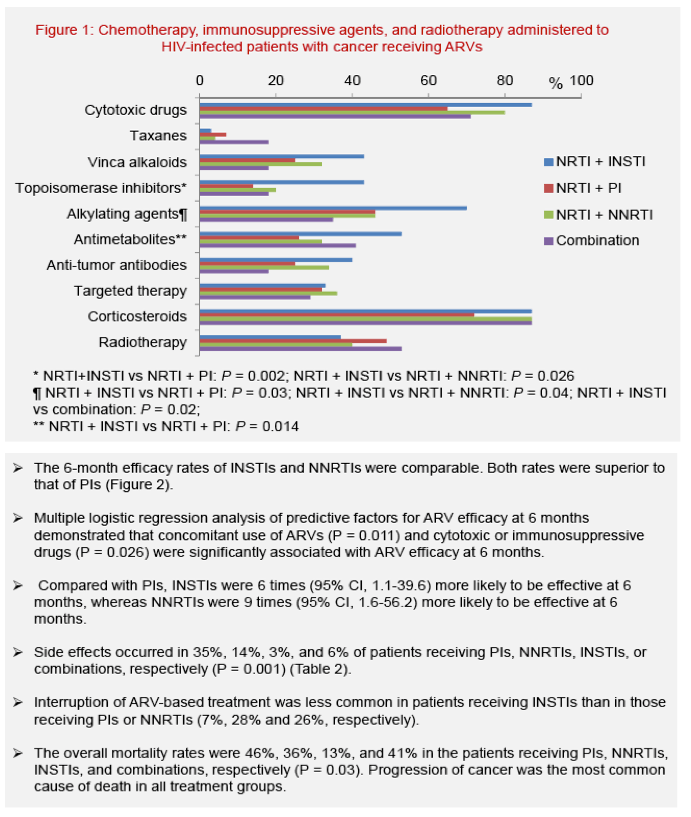
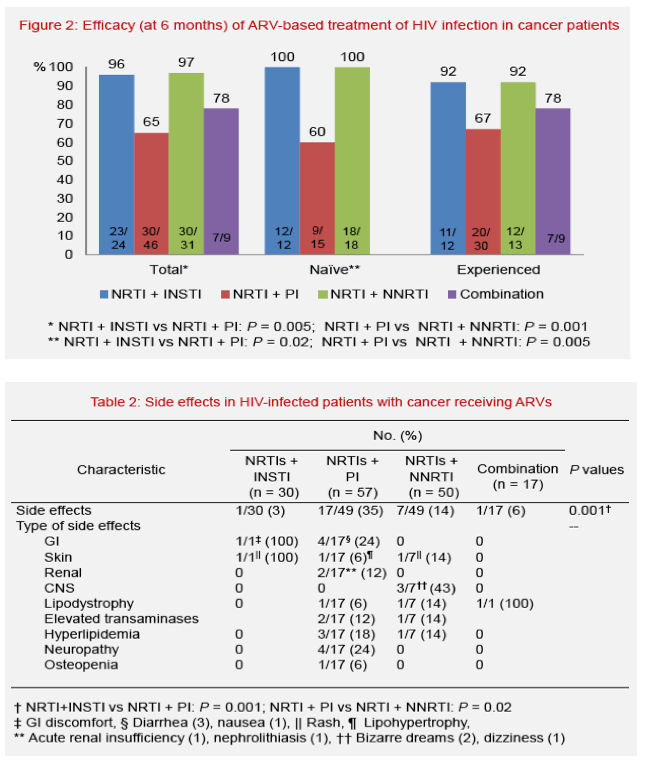
|
| |
|
 |
 |
|
|